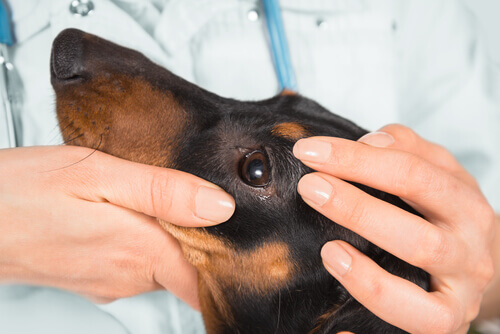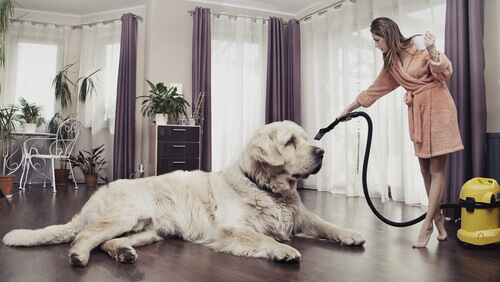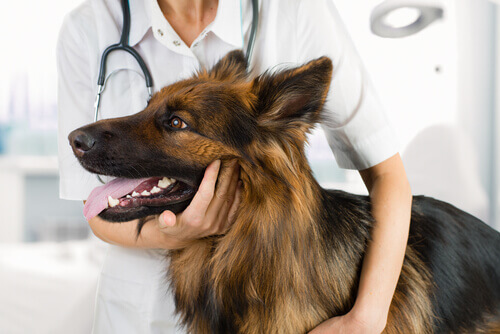Managing Seasonal Allergies in Dogs

One out of seven dogs has seasonal allergies and the symptoms manifest during certain times of the year. As with humans, this kind of condition is due to climatic changes.
Allergies are a response of the immune system to exposure to certain substances and they can affect an animal’s skin, respiratory tract, or digestive system.
Hypersensitivity to pollen is the leading cause of seasonal allergies in dogs. The symptoms that require medical attention begin to appear after inhaling these particles, released by plants during their reproduction.
Unequivocal signs of allergy
Allergy discomforts are different in every dog, but there are some common ones when it comes to pollen. The most visible symptom is red skin and you may notice it because the dog is probably licking and biting the area. Either that or they may be rubbing against the walls or objects to relieve the itching.
Persistent itching can affect sensitive parts of their bodies such as the muzzle, armpits, ears, and eye area. A dog may lose hair in some parts of the body in extreme cases.

They may also have symptoms such as pink eye, sneezing, diarrhea, vomiting, snoring, and throat inflammation. Itching at the base of the tail is usually due to flea allergy. Hence the need to learn to differentiate these reactions.
Discomfort when outdoors
Being outside may worsen the conditions of a dog with seasonal allergies, so try to keep them indoors — if the animal can do without going out. Their symptoms may appear or worsen when they’re in the yard, the patio, or near certain plants. You’ll recognize the symptoms because the animal will be anxious and licking themselves excessively
Shrubs and lawns they’re used to having around will make them sneeze and could also lead to behavioral changes. So, take them away from this environment if you notice these symptoms.
It isn’t always easy to protect dogs from agents such as pollen but you must try to minimize it, especially if a vet has confirmed the diagnosis.
How to prevent seasonal allergies in dogs
The goal here is to diminish the consequences of seasonal allergies. You must clean the dog’s paws every time they go out for a walk and also upon their return. This is because the grooves or folds collect a lot of this dust. As you can see, proper hygiene in this area is your main form of prevention.

You must take steps to avoid pollen in your home. Either wipe your shoes or take them off when entering your place. Also, vacuum the floors often so as to keep them free of dust.
Other seasonal allergies
There are other seasonal allergies, such as flea bites, that have a bad effect on dogs. They manifest as visible rashes on skin and hair.
You must administer antiparasitics to a dog before the season begins in order to prevent the action of these bloodsuckers. Also, there are shampoos and injectable medications that help prevent their appearance. It’s important to consult a specialist before using any medication for this purpose.
Food allergies are also common although they don’t afflict an animal as often as the previous ones. The solution for these is simple: just change their diet accordingly.
How to strengthen a dog’s immune system
All dogs are prone to seasonal allergies but you can prevent them by strengthening their immune system. The key is to provide the essential nutrients their organism requires.
The types of food that are high on omega-3 fatty acids and antioxidants help prevent allergies by strengthening an animal’s immune system. Thus, pets whose menus contain these elements are less prone to bacterial and viral conditions.

Another way to control these conditions is to use specialized products for your dog’s fur. Regular checkups with your veterinarian must also be a priority in order to ensure the animal’s overall health.
Pay attention to any changes in a dog
Most dogs with allergies have them throughout their entire lives. Their symptoms manifest during the first to the third year of age but you can control them with proper care.
Healthy skin is the strongest barrier against allergies and can keep the damage from allergens, microorganisms, and other agents to a minimum. Check them often for any signs of disease that manifest as dryness, weakening, sagging, warts, redness, infection, darkening, or inflammation.
You must also monitor the animal’s mood and appetite if you think they might have seasonal allergies. These are alarm signals you shouldn’t ignore.
